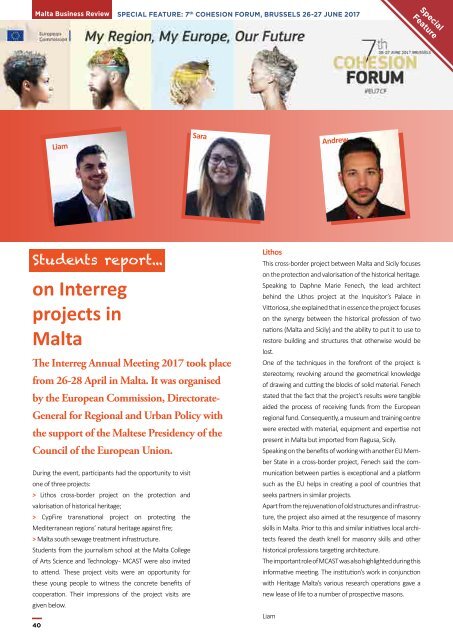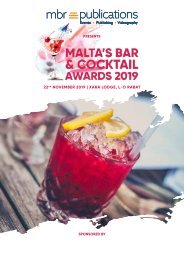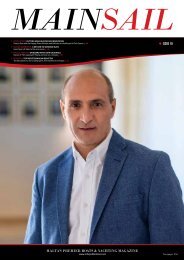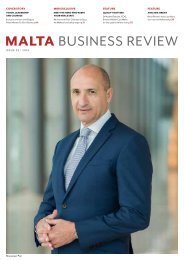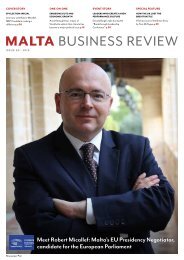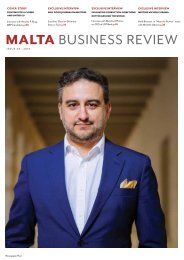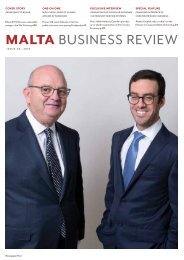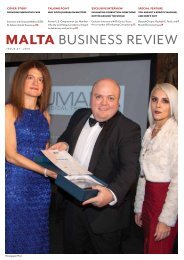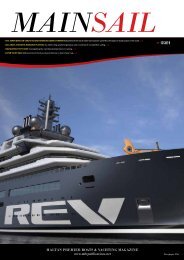MBR JULY ALL
You also want an ePaper? Increase the reach of your titles
YUMPU automatically turns print PDFs into web optimized ePapers that Google loves.
Malta Business Review<br />
SPECIAL FEATURE: 7th COHESION FORUM, BRUSSELS 26-27 JUNE 2017<br />
Special<br />
Feature<br />
Special<br />
Feature<br />
SPECIAL FEATURE: 7th COHESION FORUM, BRUSSELS 26-27 JUNE 2017<br />
Malta Business Review<br />
Liam<br />
Sara<br />
Andrew<br />
Miguela<br />
Mauro<br />
Students report...<br />
on Interreg<br />
projects in<br />
Malta<br />
The Interreg Annual Meeting 2017 took place<br />
from 26-28 April in Malta. It was organised<br />
by the European Commission, Directorate-<br />
General for Regional and Urban Policy with<br />
the support of the Maltese Presidency of the<br />
Council of the European Union.<br />
During the event, participants had the opportunity to visit<br />
one of three projects:<br />
> Lithos cross-border project on the protection and<br />
valorisation of historical heritage;<br />
> CypFire transnational project on protecting the<br />
Mediterranean regions’ natural heritage against fire;<br />
> Malta south sewage treatment infrastructure.<br />
Students from the journalism school at the Malta College<br />
of Arts Science and Technology - MCAST were also invited<br />
to attend. These project visits were an opportunity for<br />
these young people to witness the concrete benefits of<br />
cooperation. Their impressions of the project visits are<br />
given below.<br />
Lithos<br />
This cross-border project between Malta and Sicily focuses<br />
on the protection and valorisation of the historical heritage.<br />
Speaking to Daphne Marie Fenech, the lead architect<br />
behind the Lithos project at the Inquisitor’s Palace in<br />
Vittoriosa, she explained that in essence the project focuses<br />
on the synergy between the historical profession of two<br />
nations (Malta and Sicily) and the ability to put it to use to<br />
restore building and structures that otherwise would be<br />
lost.<br />
One of the techniques in the forefront of the project is<br />
stereotomy, revolving around the geometrical knowledge<br />
of drawing and cutting the blocks of solid material. Fenech<br />
stated that the fact that the project’s results were tangible<br />
aided the process of receiving funds from the European<br />
regional fund. Consequently, a museum and training centre<br />
were erected with material, equipment and expertise not<br />
present in Malta but imported from Ragusa, Sicily.<br />
Speaking on the benefits of working with another EU Member<br />
State in a cross-border project, Fenech said the communication<br />
between parties is exceptional and a platform<br />
such as the EU helps in creating a pool of countries that<br />
seeks partners in similar projects.<br />
Apart from the rejuvenation of old structures and infrastructure,<br />
the project also aimed at the resurgence of masonry<br />
skills in Malta. Prior to this and similar initiatives local architects<br />
feared the death knell for masonry skills and other<br />
historical professions targeting architecture.<br />
The important role of MCAST was also highlighted during this<br />
informative meeting. The institution’s work in conjunction<br />
with Heritage Malta’s various research operations gave a<br />
new lease of life to a number of prospective masons.<br />
Liam<br />
40 www.maltabusinessreview.net 41<br />
CypFire<br />
On 27 April I had the chance to attend the CypFire project<br />
event held by the EU Commission. Prior to visiting some<br />
sites a talk was held at the local council of Mgarr where<br />
we were greeted by the mayor Paul Vella who introduced<br />
three more speakers – Roberto Tanti, Gianni Della Rocca<br />
and Eman Vella.<br />
Each spoke of their involvement in this project. Tanti started<br />
by stating the aim of this CypFire project: to suppress forest<br />
fires with a natural barrier, cypress trees. He talked about<br />
how the project came to be with the various experiments<br />
done in different countries and the general spreading of<br />
knowledge.<br />
Della Rocca spoke about the technical aspect of the project<br />
by going into scientific detail about the properties of the<br />
particular species of trees called Mediterranean cypresses.<br />
Lastly, Vella spoke of the input the Mgarr local council had<br />
in previ- ous experiments to determine the best species of<br />
cypress to use in this natural barrier. Mgarr was the best<br />
contender for planting trees as it has the best maintained<br />
rural area in Malta and plenty of space. The trees were<br />
planted in two sites – one near Gnejna and one in Ballut – in<br />
2006 and 2012, respectively. The monitoring of these trees<br />
is still ongoing even though CypFire has ended.<br />
Sara and Andrew<br />
Ta’ Barkat sewage treatment plant<br />
The annual meeting included a visit to the sewage treatment<br />
infrastructure known as Ta' Barkat, at Xgħajra, Malta, Stefan<br />
Cachia and David Sacco, engineers within Water Services<br />
Cor- poration, discussed the project’s aim and objectives,<br />
agenda and the treatment’s key infrastructure.<br />
Cachia opened up the discourse with CF116, one of the<br />
most iconic waste projects in Malta. This operational<br />
programme was originally submitted to the Commission<br />
in December 2007 and formally submitted in July 2010.<br />
According to Cachia, CF116 re-establishes the bathing<br />
water quality along with the Bathing Water Directive and<br />
eliminates extra raw waste water which is discharged into<br />
the sea. This project also aims to get rid of all bad odour<br />
emissions in raw waste-water discharge. Cachia said the<br />
project cost around EUR 80.1 million.<br />
Sacco discussed the project’s aim and objective with<br />
regards to the reduction in pressure on natural water<br />
resources to diversify the available water supply and<br />
increase the propor- tion of reclaimed water. He also stated<br />
that the water services facilitates 90 boreholes, 10 pumping<br />
stations and 3 sea-water reverse-osmosis plants in Malta<br />
and 44 boreholes and 2 pumping stations in Gozo.<br />
The Water Services Corporation aims to continue to invest<br />
in better quality of life which leads to an investment in the<br />
future of the Maltese people. The delegation then visited<br />
the plant.<br />
Miguela and Mauro <strong>MBR</strong><br />
Creditline: European Commission, Panorama Spring 2017


